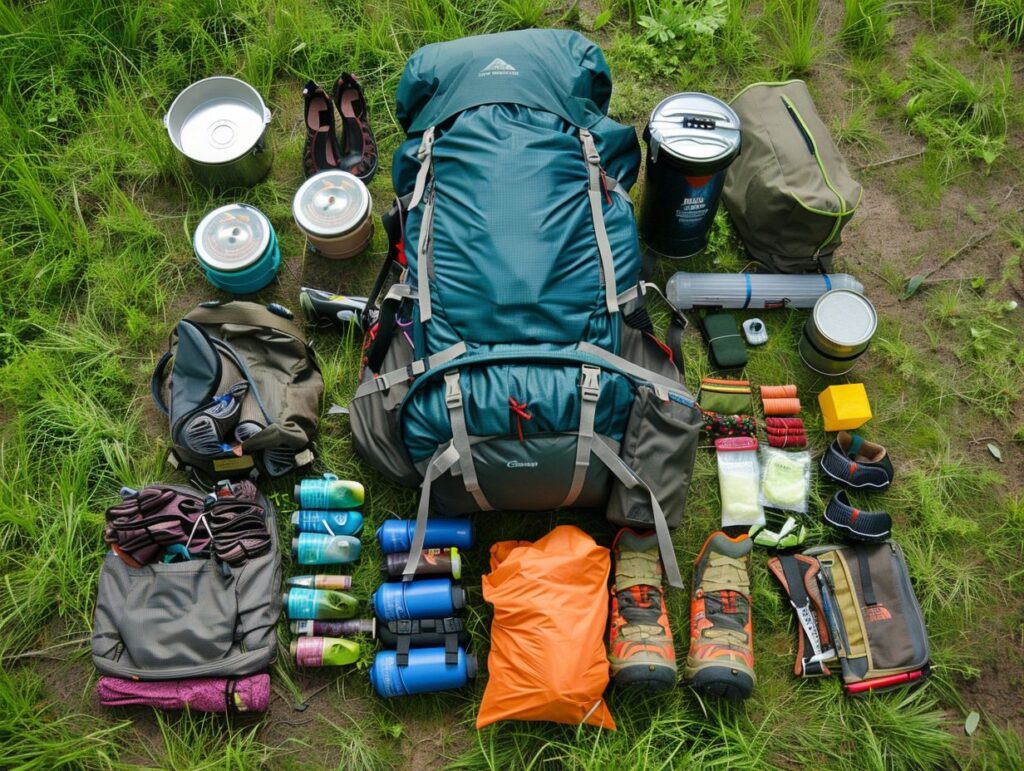Heading out on a multi-day camping trip can be an exciting adventure, but figuring out what to pack can be a daunting task.
In this article, we will explore the reasons why packing light is essential for a successful camping experience. We will also discuss important factors to consider before packing, such as the weather forecast, planned activities, and the size of your group. We will provide tips on choosing the right backpack, essential items to pack, and efficient packing strategies to minimise weight.
Whether you are a seasoned outdoor enthusiast or a novice camper, this guide will help you prepare for your next wilderness excursion.
Key Takeaways:
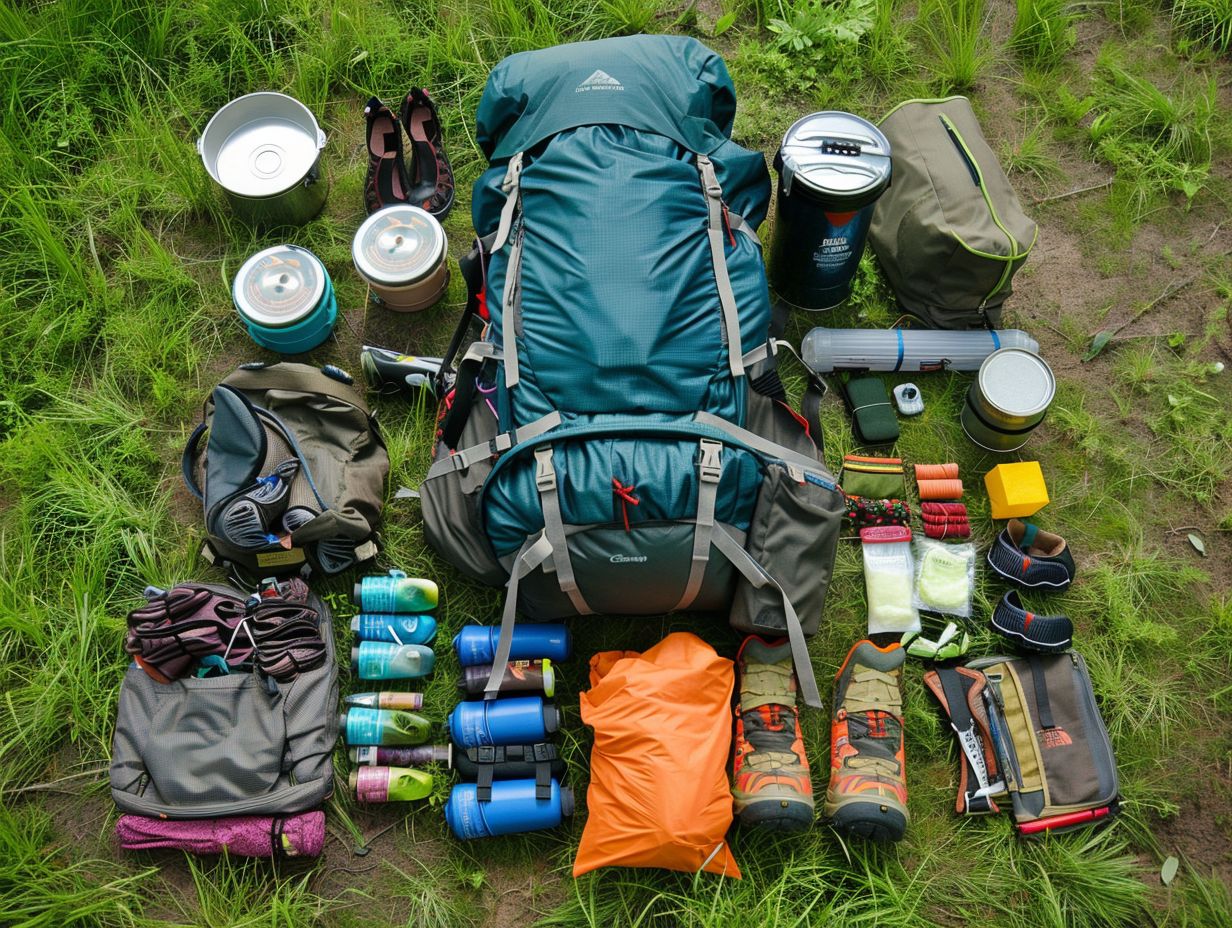
- Consider the weather and activities when choosing what to pack for a camping trip.
- Choose a backpack that fits well and has the necessary features for your trip.
- Pack only essential items, use multi-purpose gear, and distribute weight properly to pack efficiently and minimise weight.
How to Choose the Right Backpack for a Multi-Day Camping Trip
Choosing the right rucksack for a long camping trip requires consideration of factors like size, features, and weight to ensure it meets your needs and allows for the easy carrying of all gear.
What Size Backpack Do You Need?
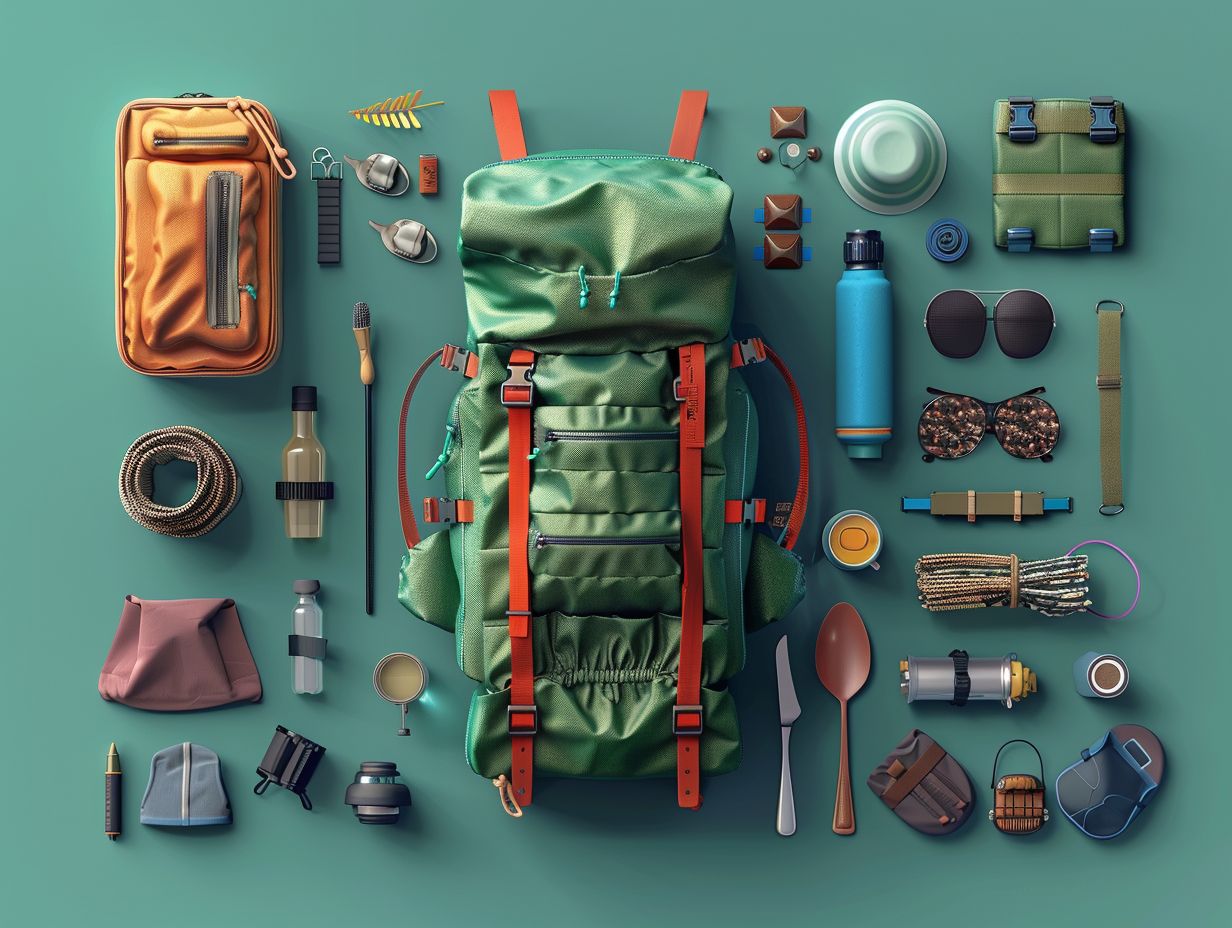
Determining the appropriate size of the rucksack is a critical consideration, as it must possess adequate capacity to accommodate all essential gear and items while maintaining a reasonable level of compactness and weight.
When strategizing for your upcoming trip, it is imperative to take into account the duration of your adventure and the quantity of equipment you intend to carry. For brief excursions, a smaller rucksack may be sufficient, whereas extended journeys with a larger quantity of gear will necessitate a rucksack with a greater capacity.
Careful consideration should be given to the specific items required and the spatial requirements they impose within the rucksack. Striking a balance between accommodating essential items and avoiding unnecessary weight is paramount.
By conducting a thorough assessment of your requirements and selecting an appropriately sized rucksack, you can ensure a travel experience that is both comfortable and efficient.
What Features Should You Look For?
When choosing a rucksack for your camping trip, it is advisable to consider features such as multiple compartments, padded straps, and waterproof materials, as these elements contribute to increased comfort and functionality.
Additionally, the inclusion of adjustable waist straps in a rucksack facilitates superior weight distribution and support during extended hikes. Opting for a rucksack with breathable mesh panels serves to enhance airflow and reduce the accumulation of perspiration.
Prioritising reinforced stitching and durable zippers in the selection process ensures prolonged usability. Moreover, selecting a rucksack with hydration compatibility affords convenient access to water while on the move.
Adhering to these packing recommendations is essential to ensure a pleasant and trouble-free camping experience.
How to Properly Fit and Adjust Your Backpack?
It is imperative to appropriately fit and adjust your rucksack to ensure weight distribution is uniform, thereby averting discomfort or potential injury throughout your camping trip.
To secure a proper fit, start by adjusting the shoulder straps to a comfortable length and tightening the waist belt to shift weight to your hips. Then, fine-tune the load lifters to bring the weight closer to your body and prevent any sagging.
Maintain weight balance by placing heavy items centrally and close to your back. Use the rucksack’s compression straps to secure the load tightly and maintain stability while hiking. Finally, adjust the chest strap for additional support and comfort. Committing to these adjustments will enhance your overall hiking experience.
Essential Items to Pack for a Multi-Day Camping Trip
Careful planning and organisation are essential when preparing the necessary items for a multi-day camping excursion, ensuring that all required equipment is included while also managing the weight of the load effectively.
Shelter and Sleeping Gear
When preparing for a multi-day camping expedition, it is crucial to prioritise the inclusion of shelter and sleeping gear in your packing list. These items are vital to ensure a safe and comfortable place for rest during your outdoor adventure.
A sturdy and weatherproof tent is essential for protection against environmental elements, serving as a secure refuge for sleeping purposes. When paired with a high-quality sleeping bag suitable for the current season, the chances of maintaining warmth and comfort throughout the night significantly increase.
Furthermore, a sleeping mat provides both padding and insulation from the cold ground, enhancing the overall comfort of your sleep. The seamless integration of these camping essentials collectively promotes an environment conducive to a peaceful night’s sleep amidst the natural surroundings.
Clothing and Footwear
Selecting the appropriate apparel and footwear for a camping excursion is of utmost importance, as it ensures readiness for a range of weather conditions and terrains. Opt for versatile clothing that can be layered to accommodate fluctuations in temperature, and prioritize moisture-wicking fabrics to promote dryness and comfort.
In case of inclement weather, it is advisable to include waterproof outerwear and additional pairs of socks to maintain dryness. For colder climates, thermal undergarments and insulated jackets should be included in the gear list. Conversely, in warmer environments, lightweight and breathable materials are recommended.
Regarding footwear, it is essential to choose sturdy options with reliable traction for hiking purposes, while considering sandals or water shoes for activities involving water. It is prudent to consult weather forecasts and anticipate planned activities to make well-informed decisions regarding packing attire and footwear.
Food and Water
Ensuring the availability of a reliable source of sustenance, including food and water, is paramount for the success of a camping expedition and necessitates thorough meal planning and the appropriate selection of supplies.
Meal planning is critical not only for guaranteeing an adequate supply of nourishment during outdoor excursions but also for minimising food wastage. By devising a meal strategy in advance, one can pack efficiently and circumvent the burden of unnecessary food items.
Additionally, the acquisition of a high-quality water filtration system serves as a protective measure against waterborne illnesses while camping. Proper storage techniques for both food and water are equally pivotal, as they serve to preserve freshness and avert contamination.
These preparatory measures collectively contribute to a more seamless and enjoyable camping experience.
Navigation and Communication Tools
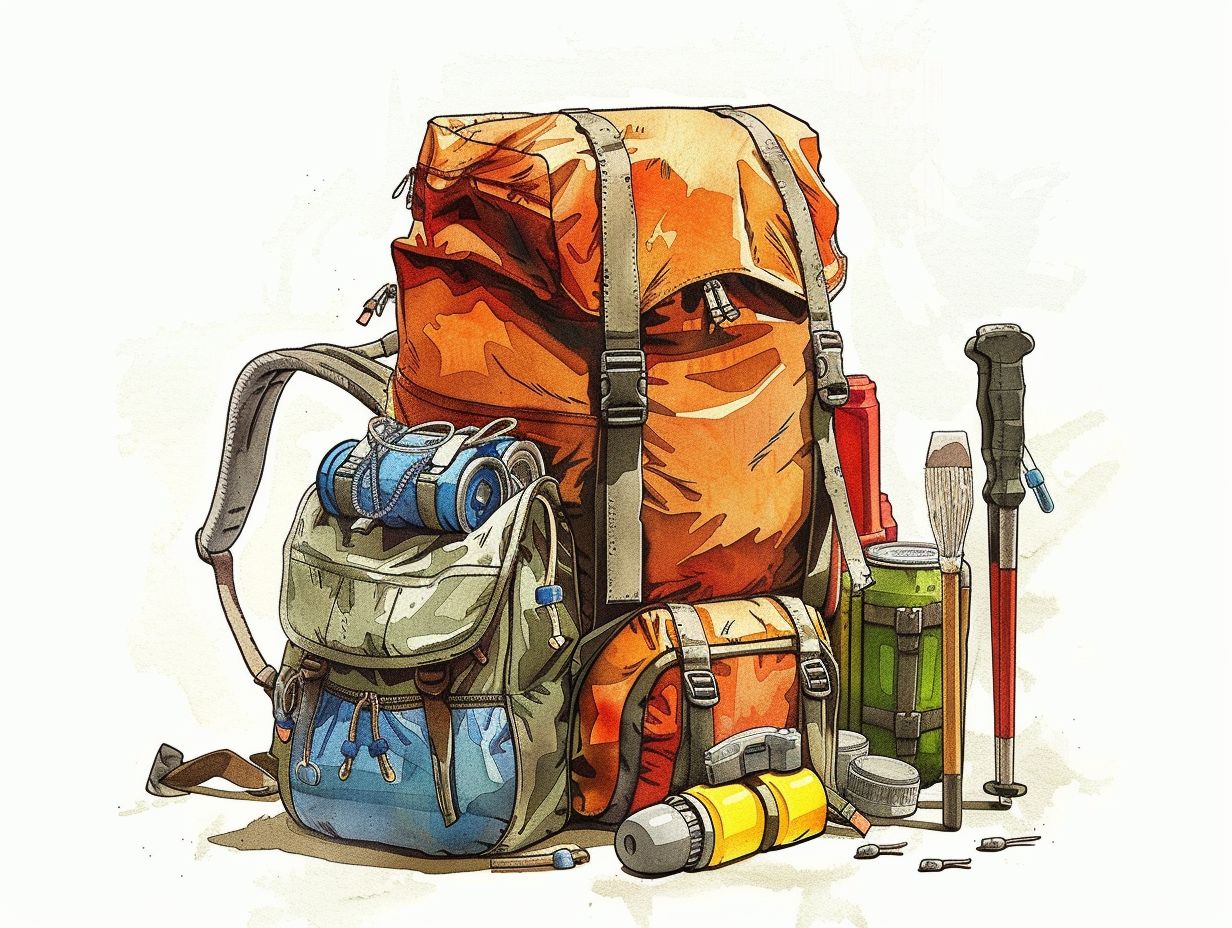
The utilisation of navigation and communication tools is imperative to ensure safety and maintain connectivity throughout the duration of a camping excursion.
In preparation for the upcoming adventure, it is advised to include essential items such as a dependable map for trail navigation, a GPS device for precise location tracking, and a two-way radio for effective communication with fellow group members.
These fundamental tools not only facilitate route finding in outdoor settings but also guarantee efficient correspondence in the event of emergencies. Moreover, carrying a compass can function as a supplementary navigation aid, particularly in regions with limited GPS signal reception.
By incorporating these critical tools into one’s camping equipment, the overall outdoor experience can be significantly enhanced, and readiness for unforeseen adversities can be ensured.
First Aid Kit and Personal Hygiene Items
It is imperative to assemble a comprehensive first aid kit and include personal hygiene items when preparing for a camping trip. Incorporating essentials such as plasters, antiseptic wipes, and adhesive tape in the first aid kit is crucial for addressing minor injuries like cuts and grazes.
Personal hygiene items like soap, a toothbrush, and toilet roll are essential for maintaining cleanliness and preventing the spread of germs. Additionally, remember to pack suncream and insect repellent to protect your skin from potential harm. Access to these items can significantly contribute to ensuring a safe and enjoyable camping experience.
Other Essential Items
Plus basic camping gear, there are several other essential items that can enhance the camping experience and ensure sufficient preparedness. Multi-tools are essential additions to one’s equipment, providing versatility for a range of tasks.
Sufficient lighting, such as head torches or lanterns, is essential for visibility and safety during night-time activities. It is also important to pack a repair kit to promptly deal with any unforeseen equipment malfunctions.
The inclusion of these additional items can significantly impact the smooth progress of a camping trip and help in handling unexpected situations effectively.
Tips for Packing Efficiently and Minimising Weight
Efficient packing and weight reduction are essential for ensuring a comfortable and pleasant camping experience. These practices enable greater freedom of movement and help minimise physical strain.
Use Multi-purpose Items
Utilising multi-functional items is a fundamental strategy for efficiently packing light, facilitating a reduction in the quantity of items required whilst ensuring all necessary provisions for the trip are met.
These adaptable items not only optimise space in your luggage but also prove valuable in various scenarios. For instance, a sizable scarf can serve as a beach towel or a picnic blanket.
Similarly, a sarong can function as a beach cover-up, a lightweight blanket during cooler evenings, or even a makeshift carrying bag. Opting for items that offer multiple uses enables a streamlined packing experience and encourages a minimalist approach to travel.
Choose Lightweight and Compact Gear
It is imperative to prioritise the use of lightweight and compact gear to ensure the manageability of your rucksack and reduce overall weight during your camping excursion.
Selecting items such as a lightweight tent, compact sleeping bag, and portable cookware can lead to a significant reduction in the bulkiness of your pack.
A compact tent not only conserves space but also facilitates easier setup, while a lightweight sleeping bag offers warmth without the burden of additional weight. Portable cookware enables efficient meal preparation without occupying excessive space.
These packing recommendations are designed to lighten your load and create space for other essential items, ultimately enhancing the enjoyment and convenience of your camping experience.
Only Pack What You Truly Need
One of the most effective packing strategies is to adhere to a minimalist approach, bringing only necessary items to ensure a lighter load. To identify essential items, it is advisable to assess the purpose of the trip and the activities that will be undertaken.
When selecting clothing items, opt for versatile pieces that can be easily mixed and matched to create various outfits, rather than packing complete ensembles for each day. Emphasise multi-functional items that can serve multiple purposes to conserve space and reduce weight.
Additionally, take into consideration the amenities available at your destination to prevent redundancy in your packing. By conducting a thorough assessment of your requirements, you can simplify the packing process and travel more efficiently as a minimalist.
Organise and Distribute Weight Properly
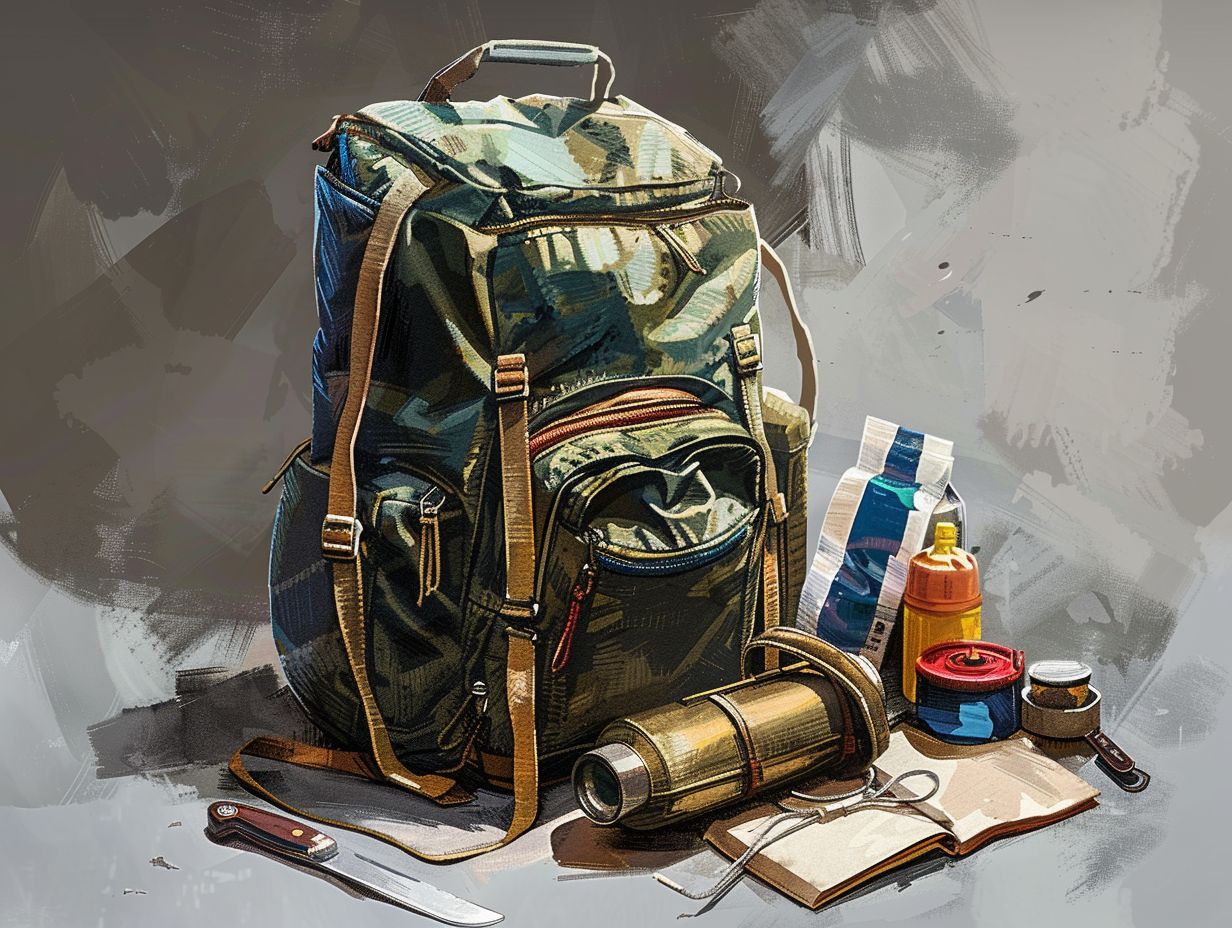
The proper organisation and distribution of weight in one’s rucksack are essential for maintaining balance and comfort during a camping trip.
One effective method for organising items is to employ packing cubes or smaller pouches to separate and categorise gear. This approach not only aids in maintaining order but also facilitates the quick retrieval of items when necessary.
Placing heavier items closer to the back serves to centralise the weight and alleviate strain on the shoulders. Another useful suggestion is to utilise the various compartments and pockets within the rucksack to evenly distribute the load. By packing gear strategically, individuals can ensure a more comfortable and efficient hiking or camping excursion.
Frequently Asked Questions
How can I pack light for a multi-day camping trip?
To pack light for a multi-day camping trip, start by making a list of essentials and stick to it. Consider the length of your trip, the weather, and any activities planned. Choose lightweight and versatile items, and avoid packing unnecessary items.
What are some essential items to pack for a multi-day camping trip?
Some essential items to pack for a multi-day camping trip include a tent, sleeping bag, sleeping pad, portable stove, cooking utensils, water filter, headlamp, first aid kit, and appropriate clothing and footwear.
How can I save space while packing for a multi-day camping trip?
To save space while packing for a multi-day camping trip, consider using compression bags or packing cubes to condense your clothing and gear. You can also pack items inside each other, such as storing your cooking utensils inside your pot.
What are some tips for packing food for a multi-day camping trip?
When packing food for a multi-day camping trip, choose lightweight and non-perishable options, such as dehydrated meals, energy bars, and trail mix. Pack food in reusable containers to save space and reduce waste. Also, plan out your meals and snacks in advance to avoid overpacking.
Is it important to distribute weight evenly when packing for a multi-day camping trip?
Yes, it is important to distribute weight evenly when packing for a multi-day camping trip. This will help with balance and prevent strain on your body while hiking. Pack heavier items closer to your back and distribute weight evenly between the left and right side of your backpack.
How can I reduce the weight of my backpack for a multi-day camping trip?
To reduce the weight of your backpack for a multi-day camping trip, consider leaving behind unnecessary items, such as extra clothing or luxury items. You can also try to find lightweight versions of gear, such as a down sleeping bag instead of a synthetic one. Additionally, make sure to properly fit your backpack and adjust the straps for a comfortable and evenly distributed load.

